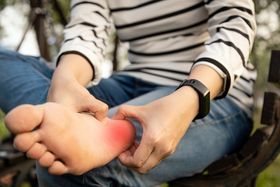Do Bunion Correctors Really Work?
Updated December 18, 2024.

There are several ways to fix bunions without surgery. The use of bunion correctors has been proven to be effective, particularly in the beginning stages of bunions. Bunion correctors help straighten your big toe, keeping it in proper alignment.
While they don’t cure bunions, bunion correctors can reduce pressure on the joints and provide pain relief. However, it should be noted that their effectiveness depends on the severity of the bunion and the type of pain you are experiencing.
How Do Bunion Correctors Work?
Repeatedly squeezing the feet into narrowly pointed footwear will place them under continuous stress. The body compensates for this by producing more bone in that area.
Unlike with bone spurs, a bony bump forms at the base of the big toe over time and turns it outwards, causing more stress on the inner side of your foot. In the case of a tailor's bunion, the bump forms at the base of the small toe. This leads to the formation of bunions.
Bunion correctors help correct the malalignment, restoring the big toe to its original position. Generally, they work to keep the toes straight by supporting the toes from the side. Over time, they force the toe back to its natural anatomic position so that the big toe can be kept straight even in the absence of the correctors.
» Discover the best insoles for flat feet that correct malalignment and help with bunions
Types of Bunion Correctors
There are slight variations in the design of bunion correctors. The design influences how and when to wear bunion correctors. Here are four types of bunion correctors.
1. Toe Spacer
These are usually made of silicone or gel and can be worn with shoes. Begin by placing them in between your big and second toes. The toe spacer pushes against the big toe until it gets to its natural position. This brings pain relief and reduces the risk of blister formation on the second toe, which usually suffers from pressure caused by the big toe.
2. Bunion Splints
Bunion splints are usually wrapped around the foot at night while you sleep to align the toes. While they do not eliminate the bunion, they help relieve any pain symptoms and limit the progression of the deformity. Over time, they can also realign the big toe back to its normal position.
3. Arch Supports
Arch supports are relevant because a clear link has been established between flat feet and bunions. By providing structural support to the arch of the foot, arch supports help keep the foot neutrally aligned and thus limit the progression of a bunion.
Arch supports exist in two forms: over-the-counter support and custom orthotics. The latter is guaranteed to bring better results.
4. Bunion Pads or Sleeves
The continuous pressure of the bunion against shoes can cause pain and swelling. Bunion pads or sleeves offer protection from pressure and friction and help relieve symptoms. They are made of gel or moleskin and can easily be slipped over the big toe and the ball of the foot.
How Effective Are Bunion Correctors?
There is evidence to suggest that bunion correctors can provide temporary pain relief and also prevent the progression of bunions. However, the effects are likely small effects that compound over time instead of a once-off, long-term result.
Aside from this, there is little evidence to suggest that bunion correctors are effective in completely getting rid of bunions.
Alternatives to Bunion Correctors
Bunion correctors are not the only way to treat symptoms caused by bunions. There are other conservative methods. Surgery is also effective in treating bunions when they cause severe pain or non–conservative methods have not yielded results.
These treatment options are discussed below.
- Non-steroidal anti-inflammatory drugs (NSAIDs) During acute episodes, NSAIDs help limit inflammation and provide pain relief.
- Physiotherapy A physiotherapist will prescribe toe exercises for bunions to relieve symptoms, limit deformity progression, and improve gait efficiency.
- Proper footwear Shoes with low heels and wide toe spaces are necessary to reduce pressure on the big toe.
- Padding or taping You can also tape or pad around the bunion to cushion and reduce pressure on the bunion.
- Custom orthotics Orthotic devices for bunions can be used to keep the foot aligned and prevent the formation of any deformity. They can also cushion the foot to relieve any excess pressure on the big toes.
- Surgery There are many kinds of surgery that can be used to remove bunions. These surgeries involve tendon, ligament, and joint repositioning to change the position of the big toe. Osteotomy and fusion surgery are two important surgical methods that can be used.








